|

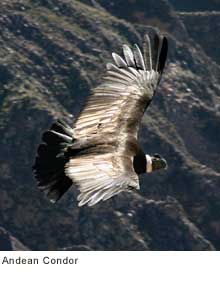 Size and Wing Span: California Condors can reach wingspans of 2.8 m (over 9 ft) and can weigh up to 8.5 kg (18¾ lb), making them one of the largest North American birds. They are only outweighed by the Trumpeter Swan (17.2 kg/38 lb), Size and Wing Span: California Condors can reach wingspans of 2.8 m (over 9 ft) and can weigh up to 8.5 kg (18¾ lb), making them one of the largest North American birds. They are only outweighed by the Trumpeter Swan (17.2 kg/38 lb),
and Mute Swan (at least 14.3 kg/31½ lb.),
an introduced species.
Although about 5 cm shorter (beak to tail), the Andean Condor undoubtedly has a larger wingspan than the California Condor. Ferguson-Lees states that the Andean Condor's wingspan is 274–310 cm (108–122 in). It is also heavier, weighing up to 11–15 kg (24–33 lb).
Plumage: The adult plumage is uniform black, with the exception of a frill of white feathers nearly surrounding the base of the neck and, especially in the male, large patches or bands of white on the wings which do not appear until the completion of the first moulting. As an adaptation for hygiene, the head and neck have few feathers (see below photo), exposing the skin to
the sterilizing effects of dehydration and ultraviolet light at high altitudes, and are meticulously kept clean by the bird.
Head and Neck: The head is much flattened above. In the male it is crowned with a caruncle or comb, while the skin of the neck in the male lies in folds, forming a
wattle. The skin of the head and neck is capable of flushing noticeably in response to emotional state, which serves to communicate between individuals.
Scavenging Stork? The middle toe is greatly elongated, and the hinder one but slightly developed, while the talons of all the toes are comparatively straight and blunt. The feet are thus more adapted to walking as in their relatives the storks, and of little use as weapons or organs of prehension as in birds of prey and Old World vultures. The female, contrary to the usual rule among birds of prey, is smaller than the male.

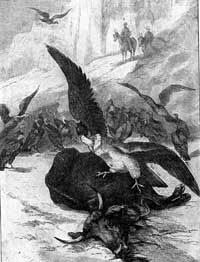 Condor Life-cycle: Sexual maturity and breeding behavior do not appear in the condor until 5 or 6 years of age. They may live for 50 years or more, and mate for life. Condor Life-cycle: Sexual maturity and breeding behavior do not appear in the condor until 5 or 6 years of age. They may live for 50 years or more, and mate for life.
The Andean condor prefers roosting and breeding at elevations of 3,000 to 5,000 meters (10,000–16,000 ft).There is a well developed social structure within large groups of condors, with competition to determine a 'pecking order'
by body language, competitive play behavior,
and a wide variety of vocalizations,
even though the condor has no voice box.
Free-flying: As they fly effortlessly through the sky, gliding in majestic circles, condors are remarkably graceful. The lack of a large sternum to anchor correspondingly large flight muscles suggests that they are build for soaring. The birds flap their wings when rising from the ground, but after attaining a moderate elevation, they seem to sail on the air. Charles Darwin commented on having watched them for half an hour without once observing a flap of their wings. They prefer to roost on high places from where they can launch without major wing-flapping effort. Oftentimes, these birds are seen soaring near rock cliffs, using the heat thermals to aid them with rising in the air.
Condor Table Manners: Wild condors inhabit large territories, often traveling 250 km (150 miles ) a day in search of carrion. They prefer large carcasses such as deer or cattle which they spot by looking for other scavengers, who cannot rip through the tough hides with the efficiency of the condor. In the wild they are intermittent feeders, often going for a few days without eating, then gorging themselves on several pounds at once, sometimes to the point of being unable to lift off the ground.

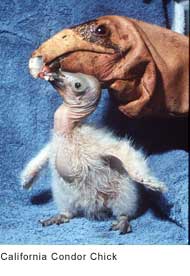 Nest and Nestling: Condors build their nests on inaccessible ledges of rock, and lay one or two bluish-white eggs, weighing about 10 ounces (280 g) and are about 4 inches (75 to 100 mm) in length, in February or March every second year. The egg hatches after 54–58 days of incubation by both parents. Nest and Nestling: Condors build their nests on inaccessible ledges of rock, and lay one or two bluish-white eggs, weighing about 10 ounces (280 g) and are about 4 inches (75 to 100 mm) in length, in February or March every second year. The egg hatches after 54–58 days of incubation by both parents.
If the chick or egg is lost or removed, another egg is laid to take its place. Researchers and breeders take advantage of this behavior to double the reproductive rate by taking the first egg away for hand-rearing, causing the parents to lay a second egg which they are generally allowed to raise.
Leaving the Nest: The young are covered with a grayish down until almost as large as their parents. They are able to fly after six months, but continue to roost and hunt with their parents until age two, when they are displaced by a new clutch.

Human Influence: Regrettably, humans have done significant damage to condor populations. Their low birth rate, late age of sexual maturity, and tendency to mate for life, all make them vulnerable to population loss. Often keepers of cattle have observed condors feeding on the dead young of cattle, and assume that the birds killed the cattle - a fallacy which led to their extermination in many areas throughout the western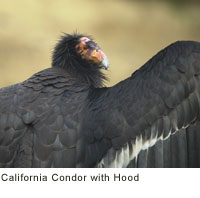 United States. United States.
This fallacy was so deeply ingrained that the reintroduction of condors to the Grand Canyon was challenged in court by distant cattle ranchers, who had been erroneously taught by their parents that the bird was a predator of calves and lambs. This delayed their introduction pending a court decision favorable to their reintroduction.
California Condor in Danger:
The California Condor remains in danger
of extinction; by 1982, only 22 individuals
were left alive, all in captivity (The 2002 population stands at about 200). Significant damage to the condor population is attributed to hunting, lead poisoning (from eating animals containing lead shot), DDT poisoning, electric power lines and habitat destruction.
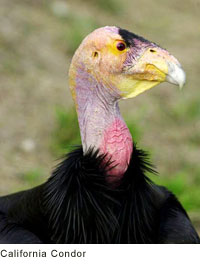 Captive Breeding: Beginning in the 1980s, a captive breeding program was undertaken to try to restore the species. Condors were released in 1991 and 1992 in California, and again in 1996 in Arizona near the Utah border. The condors were also reintroduced into the wild in the Grand Canyon national park. Their numbers are increasing steadily, particularly in the South Rim of the Canyon, where tourists may view these creatures (as they are attracted by the milling crowds of tourists). Captive Breeding: Beginning in the 1980s, a captive breeding program was undertaken to try to restore the species. Condors were released in 1991 and 1992 in California, and again in 1996 in Arizona near the Utah border. The condors were also reintroduced into the wild in the Grand Canyon national park. Their numbers are increasing steadily, particularly in the South Rim of the Canyon, where tourists may view these creatures (as they are attracted by the milling crowds of tourists).
Back in the Wild: Unanticipated deaths among these populations occurred due to contact with Golden Eagles, power lines and other factors such as lead poisoning.
Since 1994, captive-bred California condors have been trained to avoid power lines and people. Since the implementation of this aversion conditioning program, only two condors have died as a result of contact with power lines.
Lead poisoning due to fragmented lead bullets in large game waste is a particularly big problem for condors due to their extremely strong digestive juices; this lead waste is not as much of a problem for other avian scavengers such as the Turkey Vulture and Common Raven. This problem is expected to be addressed by a requirement that hunters use solid copper bullets when hunting in condor ranges.
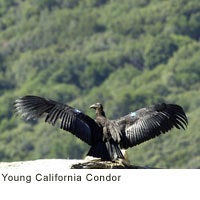 A Small Victory: In 2003 the first bird fledged in the wild since 1981. In March 2006, a pair A Small Victory: In 2003 the first bird fledged in the wild since 1981. In March 2006, a pair
of California condors were seen nesting in a hollowed out tree in Big Sur, California.
This was the first time in more than 100 years in which a pair of California condors had been seen nesting in Northern California.
All text is available under the terms
of the GNU Free Documentation License
|